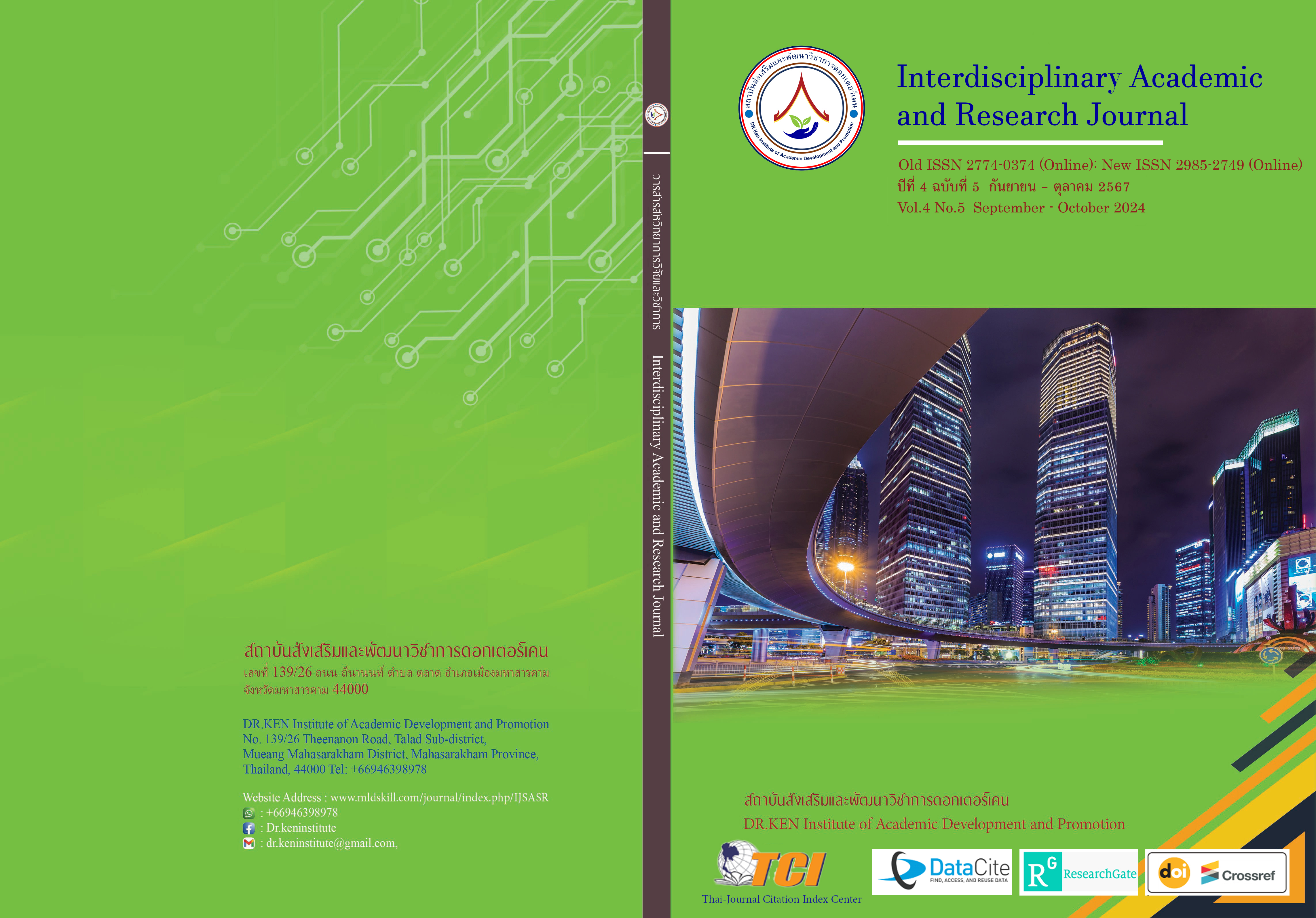Personal Characteristics of Thammasat Students Supporting Group Working
DOI:
https://doi.org/10.60027/iarj.2024.275753Keywords:
Personal Characteristics; , Viewing the World Positively; , Smiling; , Providing Assistance; , fostering Unity; , Maintaining Good Relationships; , Clear CommunicationAbstract
Background and Aims: Personal characteristics of Thammasat students supporting group work. Assessing the quality of teamwork skills in each individual is fundamental, serving as a baseline for future improvement and adjustments. The objective of the research is to study the collaborative working abilities of students, with the aim of understanding and enhancing these skills for future endeavors.
Methodology: The study focused on a sample group consisting of 201 students from the Faculty of Science and Technology, majoring in Computer Science at Thammasat University. The data collection tool utilized in this research was a questionnaire. The research approach employed was descriptive research, where data was gathered through the administration of the questionnaire and subsequently analyzed. The study aimed to investigate the collaborative working abilities of the participants in the context of their interactions with others.
Results: The results of the analysis of the ability to work collaboratively with others include aspects such as positive thinking, bright and cheerful smiles, genuine mutual support, team harmony, good interpersonal relationships, and clear communication. (1) The result of Thammasat students that is conducive to working with others Classified by personal characteristics Students of different genders Will have the ability to work with others differently but not all different in all areas There are only some areas that are different. That is, having good relations Differences in statistical significance at the level of 0.05, which is according to the assumptions set (2) The effect of Thammasat students that is conducive to working with others Classified by personal characteristics Students of different educational levels There is no difference in ability to work with others. Which is not according to the assumptions set (3) Thammasat students most can work with others. Overall, in good relations 76.44 percent.
Conclusion: The ability to work collaboratively with others requires a relationship built on effective communication, mutual empathy, trust in working together, acceptance of others' opinions, active participation, acknowledgment of others' mistakes, and understanding of others' actions. In essence, having strong interpersonal relationships, with the highest average in this aspect, is crucial for working effectively with others. This will contribute positively to future collaborations, making it a vital aspect of teamwork. On the positive thinking aspect, individual perspectives on positivity may vary, as it is a personal characteristic that is not as easily conveyed as in other areas. Therefore, the positive thinking aspect of each person tends to differ based on individual traits.
References
กรวิภา งามวุฒิวงศ์. (2559). ปัจจัยที่ส่งผลต่อการทำงานเป็นทีม ภายในสำนักอำนวยการ สำนักงานปลัดกระทรวงศึกษาธิการ. วิทยานิพนธ์ปริญญารัฐศาสตรมหาบัณฑิตมหาวิทยาลัยธรรมศาสตร์
แก้วสุข เกษมสุข. (2557). สภาพการทำงานเป็นทีมในโรงเรียนขยายโอกาสทางการศึกษา สังกัดสำนักงานเขตพื้นที่การศึกษาร้อยเอ็ด เขต 2. วิทยานิพนธ์ปริญญาศึกษาศาสตรมหาบัณฑิต มหาวิทยาลัยราชภัฏร้อยเอ็ด.
ช่อฉัตร์ บุญเฉลิม. (2557). พฤติกรรมการทำงานเป็นทีมของผู้บริหารสถานศึกษา ในสังกัดสำนักงานเขตพื้นที่การศึกษาฉะเชิงเทรา เขต 1. วิทยานิพนธ์ปริญญาครุศาสตรมหาบัณฑิต มหาวิทยาลัยราชภัฏราชนครินทร์.
ธีรวุฒิ เอกะกุล. (2543). ระเบียบวิธีวิจัยทางพฤติกรรมศาสตร์และสังคมศาสตร์. อุบลราชธานี: สถาบันราชภัฎอุบลราชธานี.
นวรัตน์ วิทยาคม. (2559). การพัฒนาผลสัมฤทธิ์ทางการเรียนและความสามารถในการ ทำงานร่วมกับผู้อื่นของนักศึกษา โดยใช้การเรียนแบบร่วมมือ ในรายวิชาระบบปฏิบัติการ. วิทยานิพนธ์ปริญญาครุศาสตรอุตสาหกรรมมหาบัณฑิต มหาวิทยาลัยราชภัฏหมู่บ้านจอมบึง.
ราชินทร์ ประสิทธิ์ (2559). P-S-Y-C-H-O หลักในการทำงานร่วมกับผู้อื่นอย่างมีความสุข. Retrieved 29 April 2023, from: http://www.acn.ac.th/articles/mod/forum/discuss.php?d=232
วรรณา อาจหาญ. (2557). การพัฒนาประสิทธิภาพการทำงานเป็นทีมของบุคลากรองค์กรปกครองส่วนท้องถิ่น ในเขตอำเภอเกาะลันตา จังหวัดกระบี่. วิทยานิพนธ์ปริญญารัฐศาสตร์มหาบัณฑิตมหาบัณฑิต มหาวิทยาลัยราชภัฏภูเก็ต.
ศิรินาถ ราชคำ. (2557). ความสัมพันธ์ ระหว่างภาวะผู้นำ การแลกเปลี่ยนความรู้ การทำงานเป็นทีม กับผลการดำเนินงานของกลุ่ม OTOP กรณีศึกษากลุ่มสนุก (สกลนคร นครพนม มุกดาหาร). วิทยานิพนธ์ปริญญาบริหารธุรกิจมหาบัณฑิต มหาวิทยาลัยวลัยลักษณ์.
สัญลักษณ์ ธรรมสุวรรณ. (2560). การศึกษาความสัมพันธ์ของการคิดบวก ความคิดสร้างสรรค์ และการแก้ปัญหาของนักศึกษามหาวิทยาลัยรามคำแหง. วิทยานิพนธ์ปริญญาศึกษาศาสตร์มหาบัณฑิต มหาวิทยาลัยรามคำแหง.
สาวินีย์ ทวยจันทร์. (2558). การทำงานเป็นทีมของเทศบาลตำบลดอนหัวฬ่อ อำเภอเมืองชลบุรี. วิทยานิพนธ์รัฐประศาสนศาสตรมหาบัณฑิต มหาวิทยาลัยบูรพา.
สุทธิชัย ปัญญโรจน์. (2561). การทำงานเป็นทีมให้ประสบผลสำเร็จ ต้องมีองค์ประกอบดังนี้. Retrieved 29 April 2023, from: https:/www.up-2be.com/การทำงานเป็นทีม
อ้อมจันทร์ ภิรมย์ราช. (2557). แนวทางพัฒนาการทำงานเป็นทีมของบุคลากรระดับท้องถิ่นในเขตอำเภอโนนไทย จังหวัดนครราชสีมา. วิทยานิพนธ์ปริญญารัฐประศาสนศาสตรมหาบัณฑิต มหาวิทยาลัยราชภัฏนครราชสีมา.
Bandura, A. (2007). Albert Bandura. In G. Lindzey & W. M. Runyan (Eds.), A history of psychology in autobiography, Vol. 9, pp. 43–75). American Psychological Association. https://doi.org/10.1037/11571-002
Krejcie, R. V., & Morgan, D. W. (1970). Determining sample size for research activities. Educational and Psychological Measurement, 30(3), 607-610.
Downloads
Published
How to Cite
Issue
Section
License
Copyright (c) 2024 Interdisciplinary Academic and Research Journal

This work is licensed under a Creative Commons Attribution-NonCommercial-NoDerivatives 4.0 International License.
Copyright on any article in the Interdisciplinary Academic and Research Journal is retained by the author(s) under the under the Creative Commons Attribution-NonCommercial-NoDerivatives 4.0 International License. Permission to use text, content, images, etc. of publication. Any user to read, download, copy, distribute, print, search, or link to the full texts of articles, crawl them for indexing, pass them as data to software, or use them for any other lawful purpose. But do not use it for commercial use or with the intent to benefit any business.
















.png)


